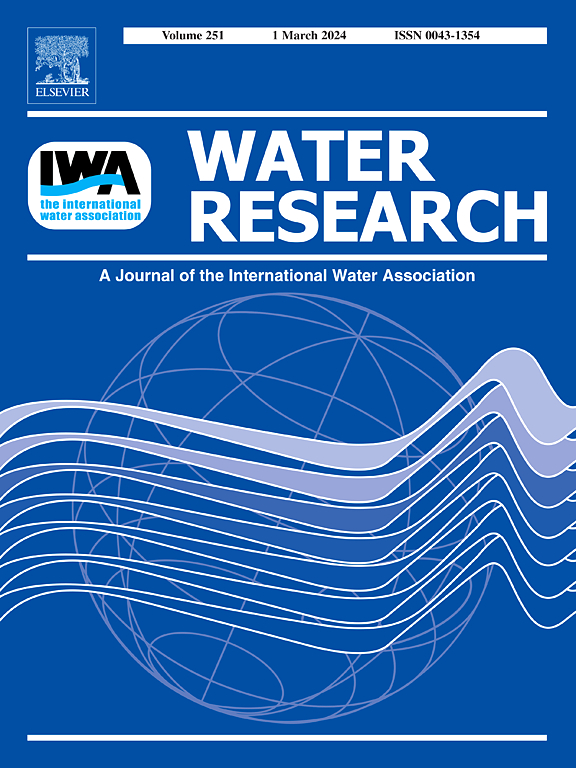超低H2O2盐介导表面氧化还原对高盐废水的超快速去污
IF 12.4
1区 环境科学与生态学
Q1 ENGINEERING, ENVIRONMENTAL
引用次数: 0
摘要
在高盐废水中最大限度地去除有机污染物,从而促进废水回收和环境保护,仍然是一个普遍的全球性挑战。目前基于羟基自由基的高级氧化工艺效率低且能耗大。在此,我们报告了一个催化体系,包括Cu(I)/Cu(II)配位的n修饰的石墨烯类结构,通过阳离子-π相互作用包裹Cu0。在盐度-污染物-水协同协同的强电场的促进下,在超低H2O2的辅助下,通过表面解理-水解循环对有机污染物进行超快破坏。该催化剂表现出高效率和稳定性,在1.5 mM H2O2消耗条件下,对高盐农药废水中总有机碳的去除率达到~ 74.5%,持续30天。对矿化度为100 mM的各种有害有机物和制药废水,降解率和H2O2利用率分别提高了18 ~ 194.1倍和5 ~ 50倍。我们的研究结果强调了盐度驱动的表面氧化还原在高盐废水处理中的潜在效用。本文章由计算机程序翻译,如有差异,请以英文原文为准。

Ultrafast hypersaline wastewater decontamination via salinity-mediated surface redox with ultralow H2O2
The cost-effective maximum removal of organic contaminants in hypersaline wastewaters, which can promote wastewater reclamation and environmental protection, remains a pervasive global challenge. Current advanced oxidation processes based on hydroxyl radicals, are inefficient and energy intensive. Herein, we report a catalytic system comprising a Cu(I)/Cu(II)-coordinated N-modified graphene-like structure encapsulating Cu0 with cation–π interactions. Salinity-mediated ultrafast destruction of organic contaminants occurs via surface cleavage–hydrolysis circulation to mineralization with ultralow H2O2 assistance, facilitated by the strong electric field from salinity–contaminant–H2O synergetic coordination. The catalyst exhibited high efficiency and stability, achieving a removal of ∼74.5 % of total organic carbon in hypersaline pesticide wastewater with 1.5 mM H2O2 consumption for 30 days. The degradation rate and H2O2 utilization increased by 18 to 194.1-fold, and 5 to 50-fold, respectively, for various hazardous organics and pharmaceutical wastewater with >100 mM salinity. Our findings highlight the potential utility of salinity driven surface redox for hypersaline wastewater treatment.
求助全文
通过发布文献求助,成功后即可免费获取论文全文。
去求助
来源期刊

Water Research
环境科学-工程:环境
CiteScore
20.80
自引率
9.40%
发文量
1307
审稿时长
38 days
期刊介绍:
Water Research, along with its open access companion journal Water Research X, serves as a platform for publishing original research papers covering various aspects of the science and technology related to the anthropogenic water cycle, water quality, and its management worldwide. The audience targeted by the journal comprises biologists, chemical engineers, chemists, civil engineers, environmental engineers, limnologists, and microbiologists. The scope of the journal include:
•Treatment processes for water and wastewaters (municipal, agricultural, industrial, and on-site treatment), including resource recovery and residuals management;
•Urban hydrology including sewer systems, stormwater management, and green infrastructure;
•Drinking water treatment and distribution;
•Potable and non-potable water reuse;
•Sanitation, public health, and risk assessment;
•Anaerobic digestion, solid and hazardous waste management, including source characterization and the effects and control of leachates and gaseous emissions;
•Contaminants (chemical, microbial, anthropogenic particles such as nanoparticles or microplastics) and related water quality sensing, monitoring, fate, and assessment;
•Anthropogenic impacts on inland, tidal, coastal and urban waters, focusing on surface and ground waters, and point and non-point sources of pollution;
•Environmental restoration, linked to surface water, groundwater and groundwater remediation;
•Analysis of the interfaces between sediments and water, and between water and atmosphere, focusing specifically on anthropogenic impacts;
•Mathematical modelling, systems analysis, machine learning, and beneficial use of big data related to the anthropogenic water cycle;
•Socio-economic, policy, and regulations studies.
 求助内容:
求助内容: 应助结果提醒方式:
应助结果提醒方式:


